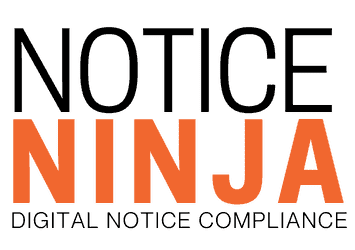Yes, NOTICENINJA is corporate tax notice compliance software that automates key workflows including notice assignments. The platform employs a rule-based system that can manage multiple level rules and ensure notices are directed to the appropriate stakeholder. As a result, you’ll never have to worry about notices being misdirected or slipping between the cracks.

Truth or Consequences? The Notice of Non Compliance False Statement

06 May
Understanding Notices of Non-Compliance: Facts vs. Fiction
Truth or Consequences? Finding the False Statement About Notice of Non-Compliance
If you’ve ever received a notice of non-compliance from a government agency—especially the IRS—you know the feeling: confusion, urgency, and maybe even panic. These official letters often look intimidating and carry serious-sounding language. But here’s the good news: they’re not always as dire as they seem.
In this post, we’ll unpack one of the biggest misconceptions about non-compliance notices: the belief that they always result in immediate penalties. We’ll separate fact from fiction, walk through how different agencies (especially the IRS) structure their notice processes, and explain what you can do to respond efficiently—and avoid unnecessary fines.
Along the way, you’ll also learn how automation tools like NOTICENINJA can help you stay ahead of compliance deadlines and eliminate the chaos that comes with tracking and resolving notices manually.
Myth-Busting Non-Compliance Notices: What’s Actually True (and What’s Not)
Which statement is false regarding notice of non compliance: A Notice of Non-Compliance always results in immediate civil money penalties without an opportunity to correct the violation.
This statement is false. In reality, most regulatory agencies provide a grace period for you to fix issues after they send a Notice of Non-Compliance—before any penalties come into play.
When that official notice arrives from the IRS, it's natural to panic.
These are formal ‘heads-up’ letters—not punishments. Think of them as a tap on the shoulder, not a slap on the wrist.
Let's clear up some common confusion about these notices:
| Statement | True or False |
|---|---|
| Notices of Non-Compliance always result in immediate penalties | FALSE |
| Recipients typically have 30 calendar days to take corrective action | TRUE |
| Notices are always preceded by informal enforcement actions | FALSE |
| Non-Compliance automatically leads to criminal prosecution | FALSE |
Most regulatory bodies, including the IRS, offer correction windows before assessing penalties. "Responsible parties have 30 calendar days after receiving a Notice of Noncompliance to take adequate corrective action before civil money penalties may be assessed." That's good news—you have time to make things right!
For compliance teams juggling multiple jurisdictions and regulatory bodies, these notices can quickly pile up. Tax directors and compliance managers often find themselves drowning in regulatory correspondence, each with different deadlines, requirements, and potential consequences.
The consistent thread through all agencies is that notices generally follow a structured process allowing for correction before penalties kick in. They're designed to guide you back to compliance, not to punish you right out of the gate.
With NOTICENINJA's automated tracking and response management, you can take the panic out of receiving these notices. Our system helps you distinguish fact from fiction and respond appropriately—before those potential penalties ever become a reality.
Responding Effectively to a Notice of Noncompliance
So you've received a notice of non-compliance. Take a deep breath! While it might feel alarming, these notices typically come with a grace period that allows you to address issues before any penalties kick in. The key is responding promptly and appropriately.
Timelines & Consequences After Receiving a Notice
Different agencies have different response windows, but most give you a reasonable timeframe to correct the issue. Understanding these timelines can save you significant headaches and expenses.
For IRS notices, the deadlines differ by notice type. A Notice 972CG for Information Return Penalties requires response within 45 days (60 days if you're a foreign filer). Other IRS notices clearly state their response deadlines right on the notice itself.
The false belief? That there's no chance to fix issues before penalties hit. Most agencies offer a clear correction window.
If you ignore these notices, consequences tend to escalate over time. What starts as a simple corrective action request can snowball into civil money penalties (sometimes accumulating daily), public disclosure of your non-compliance, suspension of activities or permits, ineligibility for government programs, and in rare cases involving willful violations, even criminal prosecution.
Consequences can escalate quickly—from accumulating daily penalties to public disclosure, program ineligibility, or, in rare cases, criminal charges. The stakes for tax compliance are too high to ignore.
Appeal Rights, Dispute Options & Escalation Path
Sometimes the notice itself might be incorrect. Most agencies allow you to dispute a notice if you act within the window—automation helps ensure nothing falls through the cracks. If you believe this is the case, you have several options to dispute the findings.
Most notices include specific instructions for disputing the findings. The IRS Notice 972CG, for example, allows you to "dispute the penalty by calling or writing with supporting documentation."
Automating Compliance: Staying Ahead of Notices
The best strategy? Prevent notices from arriving in the first place. Modern organizations are increasingly turning to automation to stay ahead of compliance issues and manage notices efficiently when they do arrive.
NOTICENINJA's OCR scan-to-capture technology transforms the entire process by digitizing paper notices, automatically extracting key data like deadlines and requirements, intelligently routing notices to the right department, tracking response deadlines, and maintaining comprehensive records of all notices and responses.
This automation is particularly valuable for organizations operating across multiple jurisdictions. Imagine being a national retailer dealing with tax notices from 50 states, 10,000 cities, and 72,000 local jurisdictions. Manual tracking becomes virtually impossible, but automation creates a manageable process.
The shift from "manual paper processes and excel spreadsheets to automated digital processes" represents a genuine paradigm shift in compliance management. Just as CRM systems revolutionized customer relationship management, compliance automation platforms are changing how organizations handle regulatory correspondence.
Effective automation gives you a centralized dashboard where all notices are visible in one place, clear status tracking showing which notices need attention, automated deadline alerts before due dates arrive, standardized response templates for common notices, and complete audit trails documenting all actions taken.
The right automation tools don't just help you respond to notices—they help prevent them from becoming problems in the first place. That's the difference between constantly playing catch-up and staying confidently ahead of your compliance obligations.
Conclusion & Next Steps
Understanding which statement is false regarding notice of non compliance isn't just an academic exercise—it's essential knowledge that can save your organization from unnecessary penalties and stress. The key false statement we've identified—that notices always result in immediate penalties without opportunity for correction—reveals an important truth: most regulatory agencies actually want to help you comply, not just punish you.
Ready to take the guesswork out of tax notices? Learn how NOTICENINJA automates compliance from scan to resolution.
More info about tax notice resolution & compliance automation software
RELATED POSTS
- The Definitive Guide to Understanding Regulatory Complexity
- Do You Need to Respond to a Compliance Letter from the IRS?
- Decoding IRS Notices: Understanding their Purpose and Intent
